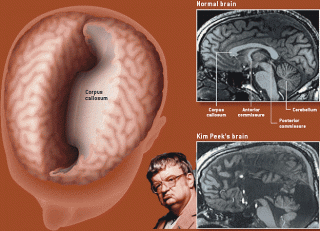Kim Peek, who lent inspiration to the fictional character Raymond Babbitt—played by Dustin Hoffman—in the movieRain Man, was a remarkable savant. A savant is an individual who—with little or no apparent effort—completes intellectual tasks that would be impossible for ordinary people to master.
Kim Peek’s special abilities started early, around the age of a year and a half. He could read both pages of an open book at once, one page with one eye and the other with the other eye. This style of reading continued until his dead in 2009. His reading comprehension was impressive. He would retain 98 percent of the information he read. Since he spent most of his days in the library with his dad, he quickly made it through thousands of books, encyclopedia and maps. He could read a thick book in an hour and remember just about anything in it. Because he could quickly absorb loads of information and recall it when necessary, his condition made him a living encyclopedia and a walking GPS. He could provide driving directions between almost any two cities in the world. He could also do calendar calculations (“which day was June 15, 1632?”) and remember old baseball scores and a vast amount of musical, historical and political facts. His memory abilities were astounding.

Unlike many individuals with savant syndrome, Kim Peek was not afflicted with autistic spectrum disorder. Though he was strongly introverted, he did not have difficulties with social understanding and communication. The main cause of his remarkable abilities seems to have been the lack of connections between hisbrain's two hemispheres. An MRI scanrevealed an absence of the corpus callosum, the anterior commissure and the hippocampal commissure, the parts of the neurological system that transfer information between hemispheres. In some sense Kim was a natural born split-brain patient.
Split-brain surgery, or corpus calloscotomy, is normally a harsh way of alleviating epileptic seizures, the occurrence of sporadic electrical storms in the brain. The procedure involves severing the corpus callosum, the main fibrous bond between the brain’s left and right hemispheres. After a split-brain surgery the two hemispheres do not exchange information nearly as efficiently as before. This impairment can result in split-brain syndrome, a condition where the separation gives rise to changes in behavior and agency.
Michael Gazzaniga and Roger W. Sperry, the first to study split brains in humans, found that several patients who had undergone a complete calloscotomy suffered from split-brain syndrome. In patients with split-brain syndrome the right hemisphere, which controls the left hand and foot, acts independently of the left hemisphere and the patient’s ability to make rational decisions. This can give rise to a kind of split personality, in which the left hemisphere gives orders that reflect the person’s rational goal, whereas the right hemisphere issues conflicting demands that reveal hidden preferences. One of Gazzaniga and Sperry's patients pulled down his pants with the left hand and back up with the right in a continuing struggle. On a different occasion, this same patient's left hand made an attempt to strike the unsuspecting wife as the right hand grabbed the villainous limb to stop it. Another of their patients, Paul S, had a fully functional language center in both hemispheres. This allowed the researchers to question each side of Paul's brain. When they asked the right side what their patient wanted to be when he grew up, he replied "an automobile racer." When they posed the same question to the left, however, he responded "a draftsman."
No comments:
Post a Comment